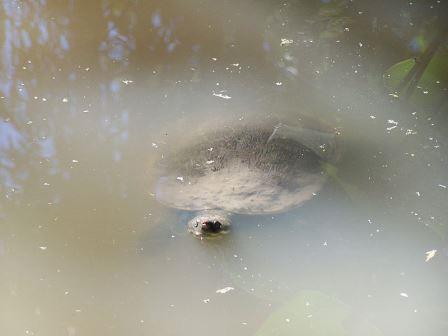Rockstar Turtle on Endangered List
Mary River turtle (Elusor macrurus) is one of a few types of cloaca-breathing turtles, which inhale submerged utilizing specific organs in their regenerative organs. This enables it to stay submerged for up to 72 hours. The Mary River turtle is a vast freshwater turtle endemic to the Mary River in Queensland, Australia. Strikingly, this turtle was kept as a pet in Australia for over 20 years before its formal depiction as another species.

This turtle is profoundly particular, both morphologically and developmentally. The rockstar look it sports with a Mohican style growth on its head which is nothing but algal growths gives it a peculiar and funky appearance. The head is its most distinctive feature and is characterized by vertical strands of green growth that additionally develop on its body. But that is not is most peculiar feature as it has gill-like organs inside its cloaca – a multi-reason hole utilized by reptiles for discharge and mating – that enable it to remain submerged for up to three days. Mary River turtle’s is one of the few species to breathe through its privates.
The Mary River turtle is recorded as Endangered by the IUCN Red List following sharp decreases since 1970. The Mary River Turtle has an uncommonly long incubation period to achieve sexual development, and does not reproduce before the age of 25.
The Mary River Turtle lives in all around oxygenated, streaming segments of streams. Its territory comprises of riffles (parts of the waterway that are gainful that are shallow, quick streaming and circulated air through) and shallow extends rotating with more profound pools. It has earthly home destinations.
The working of dams and gathering of eggs for the pet exchange have driven the decreases in the species. Be that as it may, preservation programs are currently set up to ensure the species.
The living space of the Mary River Tortoise is influenced by soil disintegration, and soil and water contamination. Living space misfortune will diminish the populace size of the species, particularly on the grounds that the tortoise hints at being regional. Dams also affect the species survival rates.
In addition, the Mary River turtle is influenced by harm to the riverside vegetation and to the structure of the riverbank. The banks of the Mary River are utilized for sand and rock mining. Sand mining brings about the loss of sand banks, stream bank disintegration and siltation of the water, and the business is common in zones which were once in the past the most gainful settling destinations of the Mary River Tortoise. A great part of the vegetation encompassing the lower and center segments of the Mary River has been cleared for farming and cows eating.
Weed invasion can cause sand banks to end up unsatisfactory for settling. Weeds such as Lantana camara obstruct the entrance of turtles to settling banks.



